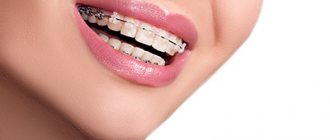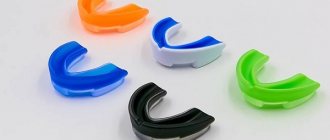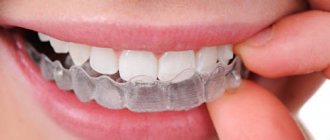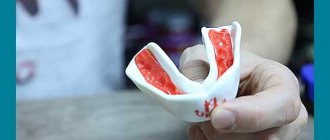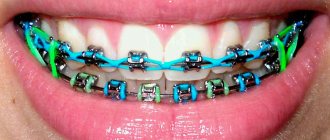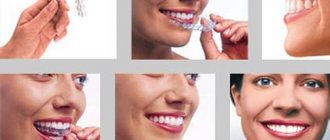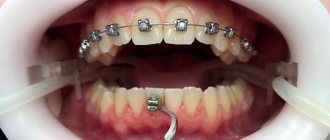In the last decade, physical activity has become one of the mandatory components of our lives. For some it helps to maintain health and youth, for others it is primarily valuable for social interaction with people of similar life interests, and still others seriously dream of Olympic medals. Therefore, orthodontists are often asked the question, “Can I play sports with braces?”
First of all, it should be noted that the increase in sports activity, generally speaking, has resulted in a noticeable increase in the incidence of dental injuries. Protective mouthguards, which became mandatory for professional football players in the USA back in 1962, and for hockey players in 1975, are used extremely rarely at the amateur level for unknown reasons in Russia. But the opportunity to make and wear a mouth guard with braces or on its own is offered by many orthodontic centers in the capital. Therefore, the correction of dentofacial defects in most cases is completely compatible with playing a variety of sports.
Why do you need a mouthguard after braces?
After removing the braces, the patient faces a retention period, which consists of wearing retainers after braces or mouthguards. These are fixed and removable structures, respectively. Retainers are a metal bracket that holds teeth in the desired position. They are installed by a doctor and are not removed during treatment. Mouthguards are removable structures that the patient wears for a certain number of hours a day. They should not be confused with a mouthguard for correcting bites, which is used independently and is an alternative to the braces system. There are also sports mouth guards for braces that protect teeth during traumatic physical activity, but they differ significantly from retention mouth guards.
Mouthguards after braces are removed are necessary to consolidate the success achieved. Many patients, after many months of wearing braces, do not want to put on another orthodontic device, do not understand why a mouth guard is needed after braces, and stop treatment. In this case, the achieved result will be lost. Refusal to wear dental trays after braces will most likely cause the teeth to return to the wrong position, and all the positive effects will be lost. Then the long period of treatment, the money spent and the time spent on straightening the teeth will be in vain. Every patient should understand why they need to wear a mouth guard after braces.
An orthodontic mouthguard after braces will not cause excessive discomfort. This fairly lightweight and discreet device ensures that teeth are held in their new position. An additional function of mouthguards is protection - they protect teeth from mechanical stress.
An alternative option is the innovative Invisalign system.
Is it possible to do martial arts with braces?
In this case, Invisalign aligners may be a more suitable option. A mouth guard can be offered to athletes with less pronounced bite defects. It is made from a transparent elastic composite using a scanned image of the jaws and bite using IT technologies. The one-piece cast design allows for quick and effective tooth alignment and is an ideal choice for athletic patients.
Similarities and differences between retention trays and alignment trays
Mouth guards are found quite often in dental practice. There are sports mouth guards, mouth guards for mineralization, for bruxism, retention mouth guards, and for teeth straightening (aligners). They differ in composition, rules of use and areas of application.
Retainers are a necessary stage of treatment after orthodontic correction with braces. If we compare them with aligners, then, despite their external similarity, their functions are radically different. Retention trays are a means of consolidating the result of treatment to hold teeth in a certain position, and aligners are an independent type of orthodontic correction. Both varieties are characterized by transparency, aesthetics and ease of use. Aligners for each person are made individually in quantities of 20-40 pieces and are changed every 2 weeks. Such mouth guards are worn constantly, being removed only when eating and brushing teeth, but retention guards, on the contrary, are worn for several hours day and night, and then only 2-3 times a week.
The period of use of retention guards depends on the patient’s age, characteristics, and clinical case. On average it is 1.5–2 years.
How to choose the right and popular brands
Features of mouth guards from different manufacturers.
- Everlast is the market leader in thermoplastic linings that provide superior oral protection. The brand's products are recommended for both beginners and experienced athletes. Mouthguards are made of plastic, EVA and EverGel technology. Country of origin: China.
- Venum - this brand's onlays are made of Nextfit Gel Frame material, have a low rise and fit the teeth perfectly. The flexibility and comfort of the two-layer system is successfully combined with the absorption of impact forces. Country of origin: Taiwan.
- Opro Gold Level UFC - the manufacturer's mouthguards are suitable for people who wear braces and dental plates. The pads are made of three-layer polymer material, are easy to install in the mouth, and are tasteless and odorless. Country of origin: Great Britain.
- Paffen-Sport presents single-layer mouth guards on the market, recommended for children and adults involved in non-professional sports. They are made of plastic and have a mint flavor. Country of origin: Pakistan.
- Flamma - mouth guards from this manufacturer have a double-sided shape, that is, they protect both jaws at the same time. They are made of high-strength rubber using two-layer technology. Country of origin: China.
Features of wearing mouth guards after braces
After removing braces, mouth guards can be made individually for the patient, but this is not necessary. In some cases, standard models are also used. Typically, mouthguards are made from biopolymers that are absolutely hypoallergenic. They do not injure the mucous membranes of the oral cavity and practically do not cause discomfort and do not interfere with eating. The patient does not have to worry about how to put on mouth guards after braces - this does not require special skills; anyone can handle this operation on their own. Questions about how to wear a mouthguard after braces usually do not arise.
However, wearing a mouthguard after braces is still a full-fledged period of treatment, and it has its drawbacks. Among them:
- provoking active salivation - hypersalivation;
- some problems with the pronunciation of certain sounds;
- frequent visits to the orthodontist.
Despite these small problems, the question is: “Do I need to wear aligners after braces?” – should not arise. The answer to this is clear - a mouth guard must be used after braces for the above reasons.
Treatment using aligners
Corrective therapy in our dental departments is carried out according to the following algorithm:
- Visit to an orthodontist by appointment. Important: treatment is possible only with a completely sanitized oral cavity;
- visual and hardware diagnostics in order to identify indications or contraindications for treatment with mouth guards;
- if indicated, the doctor performs a 3-D scan of both jaws of the patient to subsequently create a computer model of them, and also draws up a detailed correction plan;
- production of a set of mouth guards in America at the Aling Technology plant according to individual patient data;
- sending finished aligners to our clinic;
- starting a course of corrective therapy. The doctor explains the rules of wearing and care, sets the date for the next visit;
- Every 1 – 2 weeks the patient himself changes the mouthguard to the next one from the kit in numbering order.
How long to wear mouthguards after braces?
Recommendations on how long to wear mouth guards after braces can only be provided by your attending physician. Typically, the orthodontist develops a plan for how long mouth guards need to be worn after braces, which helps maintain the correct bite and minimizes possible discomfort for the patient. The doctor will indicate the approximate duration of the retention period.
Immediately after the braces are removed, the patient is usually advised to wear the aligners for a fairly long period of time every day. Most likely, you will have to wear them at night. Gradually, the time of wearing the aligners decreases: after a year, removable structures will need to be worn only once or twice a week. Typically, the timing of the entire “fixing” period is influenced by factors such as:
- type of malocclusion;
- position of teeth before treatment;
- presence of smoking addiction;
- number of teeth removed (according to indications).
Also, the retention period increases if the patient is over 30 years old. Age has a strong influence on the success of malocclusion treatment and on how long you need to wear a mouthguard after removing braces.
How to care for aligners after braces?
Simple maintenance of aligners after braces is required. However, some rules on how to care for mouthguards after braces will still have to be followed. Firstly, wearing any orthodontic appliance requires maintaining oral hygiene. Secondly, you need to be careful with your aligners so that you don’t accidentally damage them when you’re not wearing them. If the mouthguard breaks after braces, you will have to purchase or make a new one.
In addition, you should be careful when caring for the removable structure. You should not expose your mouthguards to excessively high temperatures - this will lead to their deformation, which means it may result in additional expenses. By the way, this warning also applies to drinking too hot drinks while wearing a mouthguard.
Cleaning your orthodontic appliance is quite simple. It is enough to use a toothbrush with a small amount of toothpaste and wash off the dirt with water. Orthodontists recommend cleaning your aligners both morning and evening. Sometimes experts suggest using disinfecting solutions to avoid the growth of bacteria. It is also better to store mouth guards in a special container - this will ensure their safety and hygiene. Follow these rules, and the device will last just as long as you need to wear a mouthguard after braces.
Sports tires (kappa)
A protective mouthguard is a flexible product made of elastic materials designed to protect teeth from injury in contact and other sports.
Why is it so important to wear protective dental guards?
The increase in people's sports activity and the growing popularity of new sports have led to a marked increase in cases of dental trauma. Despite the widespread use of protective mouth guards in professional sports, they are extremely rarely used at the amateur level.
Teeth can be injured when playing any sport. Dental injuries are especially common when skating and playing hockey, rugby, American football, boxing, martial arts, handball, cross-country running, and basketball. However, not only professional athletes, who are recommended to wear protective mouthguards, but also amateur athletes should wear protective equipment.
A split lip will heal, but a broken tooth will not. Did you know that teeth are probably the only part of the human body that is not able to recover on its own after injury. Emergency treatment, including dental implantation, aimed at restoring a damaged tooth or replacing a missing one, is labor-intensive and expensive.
It is not only offensive, but also stupid to lose a tooth due to an accidental hit with a racket while playing squash or falling while roller skating. By the way, such injuries can cause more harm than any blow from a boxing glove.
Properly made custom mouth guards can reduce the risk of dental injury. In addition, such mouthguards prevent tooth loss as a result of severe damage. If you or your child is involved in any active sports, such as boxing, rugby, hockey, martial arts, in which there is a risk of dental injury, then, if possible, You are advised to use protective helmets and dental guards. There are standard sports mouthguards, but at a low price, they provide a very low degree of protection.
Special studies have shown that by wearing protective mouth guards, the risk of tooth damage can be significantly reduced. In the United States, 10% of amateur hockey players and 60% of college hockey players have lost at least one tooth due to injury. Among professional hockey players, each athlete, on average, lost one or two teeth. Canadian data is quite comparable: 62% of professional players lost one or two teeth. Studies conducted in Scandinavian countries have shown that 11.5% of all accidents involve the facial area.
In amateur sports, the wearing of protective mouthguards is not promoted. Criticism is primarily caused by limited communication during the game, breathing problems and violation of aesthetics.
All these negative aspects can be eliminated with individual production of mouth guards. It has been proven that breathing resistance increases only slightly when using a custom-made mouth guard.
History of the development of protective mouth guards
As you know, a protective mouth guard was first made from a piece of rubber at the beginning of the last century. Boxers used it. During the 1921 World Championships between the Englishman Lewis and the American Britton, it turned out that mouthguards were already being produced in both countries.
In the Anglo-American literature, various synonyms have been used to denote dental protection products, such as Mouthpiece, Mouthguard, Gumshield, Guard, Shield, Defensor, Protector. These devices were retained in the oral cavity when the upper and lower jaws closed, which led to breathing restriction.
Between 1950 and 1965 In the USA, dental protection products were rapidly developing, numerous studies were conducted and various materials were tested.
In 1962, in the United States, the National Alliance Football Rules Committee decided that every football player must wear an intraoral mouth guard (mouthguard). The mouthguard had to be custom-made based on the athlete's bite pattern. Thanks to this, the number of injuries was greatly reduced. Since 1975, wearing mouthguards has also become mandatory in the United States for professional hockey players. As a result, in subsequent years there was a decrease in the incidence of dental damage in hockey from 13 to 5%.
With the modern development of dentistry, a splint-mouth guard should not be considered only as a “protective plate”, but must perform the functions of a device that stabilizes and improves muscle balance.
A properly manufactured personal protective mouthguard provides:
- prevention of injuries to teeth, gums, cheeks, tongue and jaws during training and sports competitions, minimization of injuries during recreational sports (mountain biking, roller skating, etc.), especially in adolescents
- keeping the soft tissues of the lips and cheeks away from the teeth to avoid damage to the bite or impingement of the teeth.
- absorption of the energy of blows and shocks.
- protection of antagonist teeth from occlusal contact during an accident.
- reducing the risk of jaw fracture due to shock absorption.
- protection from neurological damage due to the gap between the upper and lower jaws.
- The springy properties of the mouth guard prevent displacement of the articular heads.
- protection against concussion.
Displacement of the articular heads, hyoid bone and cervical vertebrae (C2-C4) due to wearing a protective mouth guard and opening the teeth by 2-4 mm. This is probably due to the decrease in the number of cases of cervical spine injury. In addition, the psychological aspect must be taken into account. Thanks to the feeling of security, athletes feel more confident during exercise.
It has been proven that a mouthguard can:
- improve body stability in a standing position.
- increase the flexibility of the spine.
- reduce the risk of knee injuries.
- relieve the muscles of the neck and back.
- increase reaction and speed of exercises, concentration.
Types of sports protective mouth guards:
- Junior mouthguard - worn by young athletes aged eleven to fourteen years.
- Adult mouth guard - used by adult athletes, can be used as a mouth guard for training.
- Elite mouth guard is a professional mouth guard for combat sports (boxing, kickboxing).
- A mouth guard for a hockey player - the functions of this mouth guard are disproportionately higher. Protect your teeth and protect your brain.
Types of sports protective mouthguards:
- professional - recommended for athletes who engage in sports that involve full contact, as well as sports that involve contact with various sports equipment (sticks, pucks, sticks, etc.). Sports: full contact martial arts, boxing, kickboxing, ice hockey, field hockey, rugby, polo and others. Characteristics of a professional protective sports mouthguard - it has three layers: between the two outer layers of 2 and 4 mm thick there is a super-strong layer 0.8 mm thick, which covers the most vulnerable areas of the dentition.
- semi-professional - recommended for athletes in the same cases when a professional mouthguard is recommended. It is a lightweight version of a professional sports protective mouth guard. Types of sports: all sports where a professional protective sports mouthguard is used, as well as: basketball, American football, skateboarding, ski jumping and other similar sports. Characteristics of a semi-professional protective sports mouthguard - it has two protective layers 2 and 4 mm thick. Between these layers, special reinforcement is laid in the three most vulnerable places.
- medium - recommended for a wide range of athletes with different levels of training. These mouthguards can be recommended as training structures without significant contact force load. Types of sports: as training for all previously listed sports, as well as for the following sports: mountain biking, roller skating, motocross, some types of wrestling. Characteristics of a medium protective sports mouthguard - made of two layers 2 and 4 mm thick.
- light - recommended for a wide range of athletes with different levels of training. And also for children and teenagers. In cases where it is necessary to increase the level of protection at minimal cost. In cases with children, it may need to be replaced as the athlete's jaws grow. Sports: in all of the above sports, as well as sports where there is close contact between athletes. Protects against accidental injury.
Basic requirements for a protective mouth guard:
In recent years, the requirements for mouth guards have undergone numerous changes.
- The mouth guard must absorb the energy of blows and shocks, which can only be achieved with an accurate fit, taking into account the anatomical characteristics of the athlete.
- the material from which the mouthguard is made must be elastic.
- The athlete must be able to easily take in liquid when placing the mouth guard in the mouth.
- Even with excessive physical activity, the athlete’s oxygen metabolism should not be disrupted.
- The mouthguard should be easy to disinfect, clean, and be tasteless and odorless.
- The mouth guard must exactly match the alveolar process and the dentition to prevent it from falling out during intense sports activity. A poorly fitted mouth guard forces the athlete to constantly be distracted and adjust it in the mouth.
- From the point of view of athletes, the most important signs of the quality of a mouthguard are: retention, comfort and stability, preservation of diction and breathing, as well as protection of teeth, lips, and gums.
Many hockey players train without protective masks, limiting themselves to only a visor, which, unfortunately, only protects the eyes and the bridge of the nose. Many people make do with just a helmet without a visor.
It would seem that none of the players are deprived and do not spare money on equipment - where do the injuries come from? But almost everyone has the most vulnerable place - the face and neck. Neck protectors can be purchased at a hockey store, just like a regular single-ply standard mouth guard. However, the functional properties of the latter are very doubtful. For hockey, it is recommended to make a professional individual multi-layer protective mouth guard and use the mouth guard during training and games.
The process of making a custom mouth guard occurs in 3 stages:
- at the first stage, the indications for a particular type of mouth guard are determined, the color and, possibly, the symbolism of the mouth guard are selected. The dentist takes impressions of your teeth (upper and lower jaws). After this, a technician in the laboratory makes a special wax template.
- On the second visit, using this template, the dentist determines the relationship between the upper and lower teeth, which will ensure more accurate production of the mouthguard and increase your comfort while wearing it.
- at the third stage, you receive a custom-made mouthguard in a stable, hygienic case and recommendations from your doctor on how to care for it.
On average, the entire process of making a custom sports mouth guard takes 7-10 days, and each visit lasts 15-20 minutes.
Your feelings:
- The process of taking impressions and determining the relationship of the jaws using a wax template is absolutely painless.
- When worn, the mouthguard does not cause any particular discomfort; it is easily and securely fixed on the teeth, and you just feel like your teeth have become a little larger.
The mouth guard is an active component of an athlete's protective equipment! In order to play long and successfully, and not end your career prematurely due to various injuries, you need to use all modern means of protection.
Investments in one’s own health have always been justified, since this is the most valuable thing for a person.
Mouth guards after braces - price
Prices for mouth guards after braces are removed, as well as for other orthodontic services, largely depend on the level of dentistry in Moscow, quality and type. When paying for treatment with a braces system as a set, turnkey, mouthguards are included in the price. This should be discussed in advance during your visit to the orthodontist. If the patient paid for all procedures separately, then the price for mouth guards will be from 5,000 rubles. This is not the most expensive part of treatment with braces.
Retention trays are very convenient for consolidating the success of orthodontic treatment. If the patient fulfills all the doctor’s requirements and wears the device for the required amount of time, the result achieved in the process of correcting the bite will remain forever. Be sure to wear mouthguards after braces - and straight teeth will be a source of pride.
What is more effective
The task of mouthguards and braces is the same - to correct the bite and straighten the teeth. Aligners became known only 20 years ago, but are already very popular among doctors and patients. These designs are chosen as often as braces. An aligner is a plate that is placed over your teeth. It is impossible to say exactly which brand of mouth guards is best. Treatment with all models of structures gives excellent results. The only difference is the price. Correction with aligners is comfortable and painless.
Sign up for free 3D modeling of your future smile!
Make an appointment
*By making an appointment you consent to the processing of your data
It only takes a few days to adapt. A significant advantage of aligners is invisibility. If you want to hide the use of a corrective structure, choose mouth guards. A lingual brace system, which is attached to the inside of the teeth, is also suitable.
When wearing metal systems, the treatment will last a little less. They do not change color, are durable and comfortable. The only disadvantage of metal braces is that they cannot be hidden from the eyes of others. But there is a way out. In this case, ceramic or sapphire models are suitable for you. When a patient comes to the Propricus clinic, the orthodontist offers him several correction options. The doctor talks about the features of each method, all the pros and cons. Our task is to help make an informed choice, a method of bite alignment that suits the patient’s priorities and capabilities.

